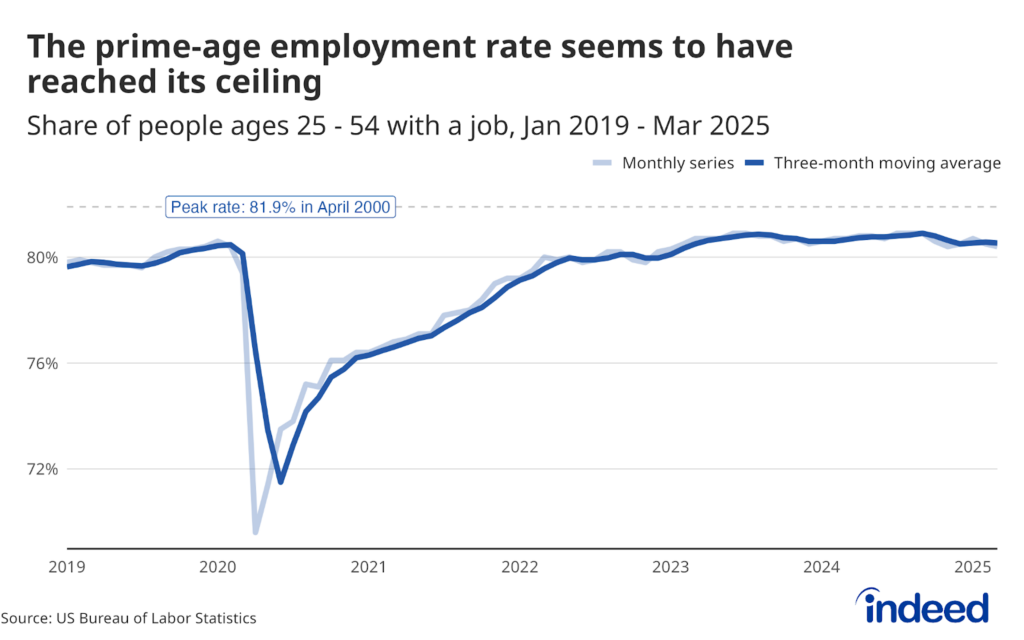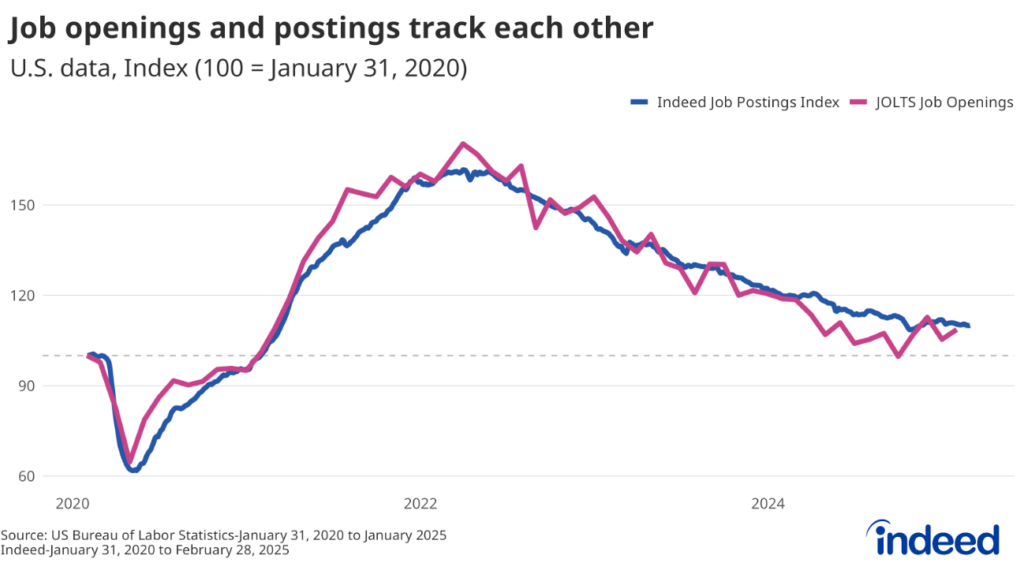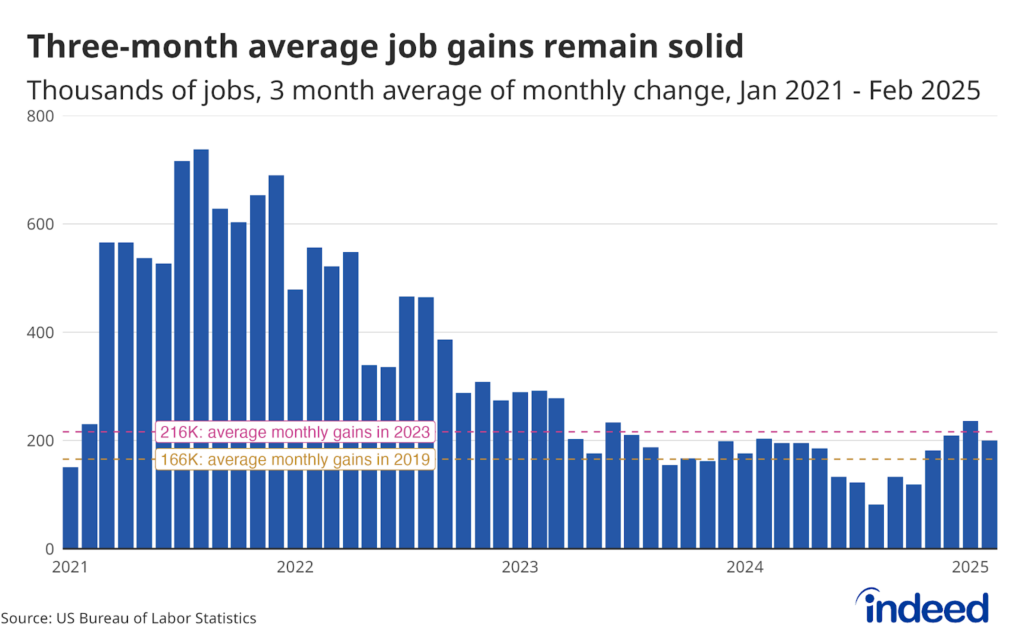Key Points
- Employer demand for interns this year is lower than 2021, but closely follows pre-pandemic trends.
- Opportunities for remote internships in March 2022 made up 8.7% of internship postings on Indeed’s US site, nearly 10 times higher than in March 2019.
- Job seeker searches for internships lag compared with 2019 and 2021, though they are rising quickly.
Summer is just around the corner which means employers are ramping up their search for interns. That’s happening in the midst of a strong labor market. Last summer, there was an employment boom for young people as the share of workers ages 16-19 with a job rose above pre-pandemic levels. Barring any disruptions from COVID-19, this summer looks promising as well.
Internships are often a microcosm of the overall labor market. As such, they broadly echo strong employer demand for workers across sectors. But job seeker interest in internships continues to track below trends in previous years. That could reflect diminished enrollment rates at universities and rising wages that pull potential interns into other positions.
Remote internship postings on Indeed boomed last year and continue to make up a substantial portion of available internships in some sectors. Internships are often a pipeline to entry-level jobs, which makes it important to examine how employer demand for interns and job seeker interest in these positions are shaping up.
Internship job postings on par with pre-pandemic trend
Last year’s improving COVID-19 situation helped unleash employer demand for interns, similar to what was happening in the broad labor market. This year, overall job posting numbers on Indeed have slightly cooled. Internship job postings have followed suit and now closely match their pre-pandemic trend. As of March 31, 2022, internship postings were 14.8% above their February 1, 2022 baseline. By comparison, they were 17.9% and 14.7% above baseline on March 31, 2021 and 2019 respectively.
As COVID-19 restrictions are eased and the public health situation improves, employer demand for interns matches pre-pandemic levels. As some regular employees return to offices, in-person internship programs are back on the table.
Remote internships have stuck around
Despite this rebound in in-person internships, remote options have established themselves as a significant practice. The pandemic forced millions of jobs to be performed away from traditional workplaces and internships were no exception. In March 2022, 8.7% of internships offered remote work, down from 11.8% during the same month last year, but still nearly ten times higher than in March 2019.
This suggests that remote internships have staying power in the US, in line with Indeed Hiring Lab research analyzing remote work trends across 20 OECD countries. An advantage of remote work is that it potentially widens internship applicant pools. It may also make internships more appealing to young workers who want flexibility and freedom from employment barriers such as moving expenses.
Internship opportunities range across sectors
Internship opportunities vary widely across occupational sectors. In March 2022, fields such as administrative assistance, software development, and marketing made up almost a quarter of all internship job postings on Indeed. On the other end of the spectrum, sectors like dental and hospitality & tourism offered few internships.
The availability of remote internships this year varies substantially across sectors, as in 2021. Marketing had the highest share of remote postings, with over 20% of internship job ads advertising remote work. Remote internships were also common in administrative assistance and software development, but were scarce in sectors such as pharmacy and food preparation & service, where working away from a central facility is impractical.
Searches for internships yet to catch up
In 2021, job seeker interest in internships rebounded from its muted levels in 2020. This year, while employer demand for interns remains strong, job seeker interest has been tepid. Although job seeker searches for internships have risen quickly in recent weeks, as is common this time of year, on March 31 they constituted just 0.8% of searches on Indeed. As of that date, job seeker interest in internships was down 13.2% from 2021 and 9.7% from 2019. While employers are showing enthusiasm for internships, job seeker interest lags.
Possible explanations for dampened interest include reduced enrollment at universities and rising wages, which may crowd out internships in the labor market. Internships are traditionally filled by college students during summer break, so reduced interest may be a product of lower undergraduate enrollments. At the same time, rising wages may be pulling would-be interns into other jobs.
Conclusion
The internship job market has continued to follow overall labor market trends. In 2021, the market for interns was hot. This year, employer demand has cooled slightly, returning to levels similar to 2019. The pandemic caused employers to go remote and many internships did as well. It appears remote internships will endure. At the same time, job seeker interest in internships is lower than in previous years, although it has risen quickly in recent weeks. Sluggish job seeker interest and plenty of other employment opportunities for young workers pose potential roadblocks for employers looking to fill internships. Employers eager for summer interns should start the hiring process now, especially since this year’s internship market appears to favor job seekers.
Methodology
Data on job postings in this blog post are the percentage change in postings on Indeed’s US site since February 1 by year using a seven-day trailing average. All figures are limited to the US. We define internship and remote job postings using an extensive list of keyword terms like “internship,” “remote work,” “telework,” and “remote based.” This methodology differs from the definitions used in previous blog posts examining remote work and internships and therefore is not comparable. Interest in internships is defined as any search query containing “intern” or “internship.”






